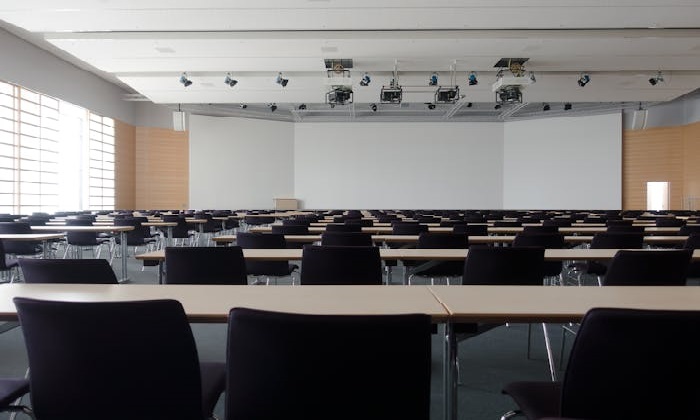Large meeting spaces, whether in corporate offices, universities, or event venues, come with unique audio challenges. From echoes and dead zones to microphone feedback and inconsistent sound coverage, poor audio can disrupt meetings, frustrate participants, and reduce overall productivity. Optimizing audio in these spaces is crucial for clear communication, engagement, and professional presentation.
In this blog, we’ll share 10 practical tips for optimizing audio in large meeting spaces, helping you ensure everyone hears clearly, whether in-person or participating remotely.
1. Conduct an Acoustic Assessment
Before making any changes, perform a thorough acoustic assessment of the space. This includes:
Measuring room size and shape
Identifying reflective surfaces like glass or concrete that cause echo
Evaluating existing audio systems
Mapping seating arrangements
Understanding the room’s acoustic characteristics allows you to select the right audio equipment and design effective sound coverage.
2. Invest in High-Quality Speakers
Not all speakers are created equal. For large meeting spaces:
Use full-range speakers capable of delivering clear audio across the room
Consider column or line array speakers for even coverage and minimal dead zones
Ensure speakers are strategically placed to reach all participants without creating hotspots
High-quality speakers ensure that everyone, even at the back of the room, can hear clearly.
3. Use the Right Microphones
Microphone choice is critical for large spaces. Consider:
Lavalier or lapel mics for presenters who move around
Boundary microphones for conference tables
Shotgun or directional mics for stage presentations
Wireless options to allow mobility without tripping hazards
Choosing the right microphone reduces feedback and ensures consistent audio pickup throughout the room.
4. Optimize Speaker and Microphone Placement
Proper placement prevents echo, feedback, and uneven coverage:
Keep speakers away from microphones to avoid feedback loops
Position speakers at ear level when possible
Angle speakers to cover seating areas evenly
Avoid placing microphones too close to walls or reflective surfaces
Professional installation ensures audio is balanced across the entire meeting space.
5. Manage Room Acoustics
Room acoustics significantly impact sound quality. Consider:
Acoustic panels on walls to absorb reflections
Carpets or rugs to reduce echo on hard floors
Curtains or drapes for large windows
Ceiling clouds or baffles to minimize sound bounce
These measures help control reverberation and improve clarity.
6. Use Digital Signal Processing (DSP)
DSP technology can fine-tune audio for large meeting spaces:
Equalize frequency response to reduce echo and muddiness
Adjust gain levels for microphones and speakers
Implement automatic feedback suppression
Enable room-wide volume balancing
DSP ensures consistent sound quality regardless of where participants are seated.
7. Integrate with AV and Video Conferencing Systems
Many large meeting spaces host hybrid meetings. Audio must integrate seamlessly with:
Video conferencing platforms (Zoom, Teams, Google Meet)
Projectors or large displays
Room control systems for lighting and AV management
Proper integration prevents technical issues and ensures remote participants can hear everything clearly.
8. Test and Calibrate Regularly
Audio optimization isn’t a one-time task. Regular testing and calibration are essential:
Test microphones, speakers, and mixers before each event
Measure sound levels in different areas of the room
Adjust audio settings based on occupancy and layout changes
Record test sessions to evaluate clarity and balance
Routine calibration maintains audio quality over time and prevents last-minute problems.
9. Train Staff and Users
Even the best audio systems fail if users don’t know how to operate them:
Provide training for AV controls, microphone operation, and volume adjustment
Create simple guides or QR codes linking to instructions
Encourage presenters to test their microphones before speaking
Assign AV support staff for large or critical meetings
Proper training ensures smooth operation and reduces disruptions.
10. Partner with Professional AV Consultants
Large meeting spaces are complex, and professional AV Consultants can make a huge difference:
Conduct acoustic assessments and recommend equipment
Design audio layouts for optimal coverage
Handle installation, calibration, and integration
Provide ongoing maintenance and troubleshooting
Consultants, like AVCore India, help you maximize ROI on your AV investments and ensure audio works flawlessly for every meeting.
Bonus Tips
Use multiple speakers to distribute sound evenly rather than relying on one powerful speaker.
Consider wireless audio monitoring to check sound quality in different seating areas.
Plan for scalability if the room will host larger events in the future.
Record audio tests to identify problem areas before live sessions.
Conclusion
Optimizing audio in large meeting spaces is critical for professional communication and engagement. By addressing acoustics, choosing the right microphones and speakers, implementing DSP, integrating with video systems, and partnering with professional Audio Video Consultants, organizations can create clear, consistent, and immersive audio experiences.
With these 10 tips, your large meeting space will deliver sound that ensures every participant—whether in-person or remote—hears clearly, enhancing productivity and engagement across the board.


